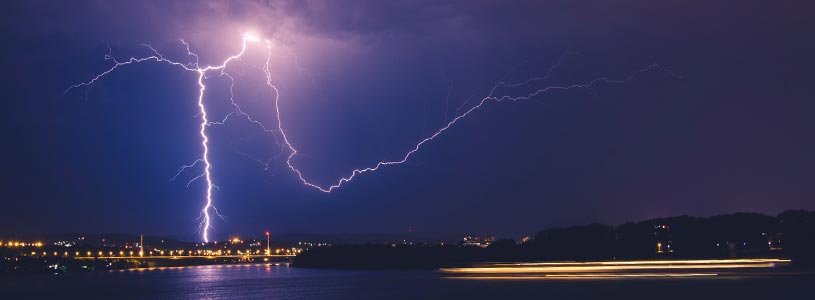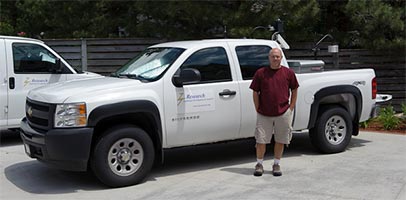

What is upward lightning?
Over the past few years, Dakota USA native Tom A Warner and his colleagues have been filming lightning on high-speed cameras. They have captured 776 naturally occurring lightning flashes, recording speeds as high as 100,000 images per second. Forty-one of the flashes were upward flashes originating from tall towers in Rapid City. Recording at speeds this high allows a detailed examination of what happens during lightning strikes, and Tom has done a lot of work on upward lightning.
Upward Lightning
The most important finding about upward lightning is that it primarily occurs when there is a nearby positive cloud-to-ground flash. The electric field change caused by the preceding flash causes an upward positive leader to initiate from a tall object such as a building, tower or wind turbine. The shape of the tall object and the resulting enhancement in the electrical field makes it possible for an upward leader to form following a nearby flash. Tom and his colleagues call this lightning-triggered upward lightning, and the upward leader would not develop if the tall object were not present. This is shown below in a fascinating high-speed video.
Source: Downward Positive Cloud-to-Ground Lightning Flash Triggers Upward Positive Leaders from Towers from ZT Research on Vimeo.
Another lightning series below
Source: Lightning captured at 7,207 images per second from ZT Research on Vimeo.
During winter snow storms, Tom's research also shows that tall objects can initiate upward leaders without preceding triggering flashes. These findings are very important because many tall structures are being built, especially wind turbines. These structures are experiencing lightning currents from upward lightning at a much higher rate than they might experience from normal downward lightning, even up to 100 times more often. Therefore, there is a much greater chance of damage. Also, it is unclear what global atmospheric impacts (i.e. atmospheric chemistry), if any, may result from the increase in lightning (specifically upward lightning) due to artificial tall objects.
Technical Information
Tom's high-speed captures use Vision Research Phantom cameras which can record over 100,000 images per second. The cameras are operated manually. Even with 16 GB of memory, the camera can only record about 2 secs video. Therefore, it continually records using a buffer loop. When a flash occurs, they trigger the camera system at the end of the flash, and the system saves the preceding 2 sec of video. The captured flash is somewhere in the saved recording, which they then download to hard drives.
The video plays back on the computer at 30 images per second, so watching a 1-sec flash recorded at 10,000 images per second would take 5 1/2 minutes. Likewise, a 1-sec flash recorded at 100,000 images per second would take over 55 min to watch. Tom and fellow students, therefore, spend most of their winter looking at and analyzing the high-speed recordings.
What is really interesting is that upward lightning occurred at St Peter's Basilica only hours after the pope resigned in February 2013.
Read more about lightning photography in this blog on how to photograph lightning strikes.
About Tom A Warner
 Tom was born in the USA in 1965 and has a first degree in Atmospheric Sciences from the University of California and a Masters in Atmospheric Science from South Dakota School of Mines and Technology. He worked as a research scientist for the Institute of Atmospheric Sciences, Rapid City, South Dakota, from 2000 to 2004, where he piloted the armour-plated T-28 Storm Penetrating Aircraft.
Tom was born in the USA in 1965 and has a first degree in Atmospheric Sciences from the University of California and a Masters in Atmospheric Science from South Dakota School of Mines and Technology. He worked as a research scientist for the Institute of Atmospheric Sciences, Rapid City, South Dakota, from 2000 to 2004, where he piloted the armour-plated T-28 Storm Penetrating Aircraft.
Tom is currently working toward a PhD degree in Atmospheric and Environmental Sciences from the South Dakota School of Mines and Technology.
Tom is also a photographer specializing in aerial, weather, lightning and night/low-light still imagery. In 2007, he used high-speed digital cameras to capture lightning.
Read about the UPLIGHTS project.
See more of Tom's lightning videos on Vimeo
Lightning can strike the ground, the air, or inside clouds, but there are roughly 5 to 10 times more cloud flashes than cloud-to-ground flashes. Discover the different types of lightning in this MetMatters post.


